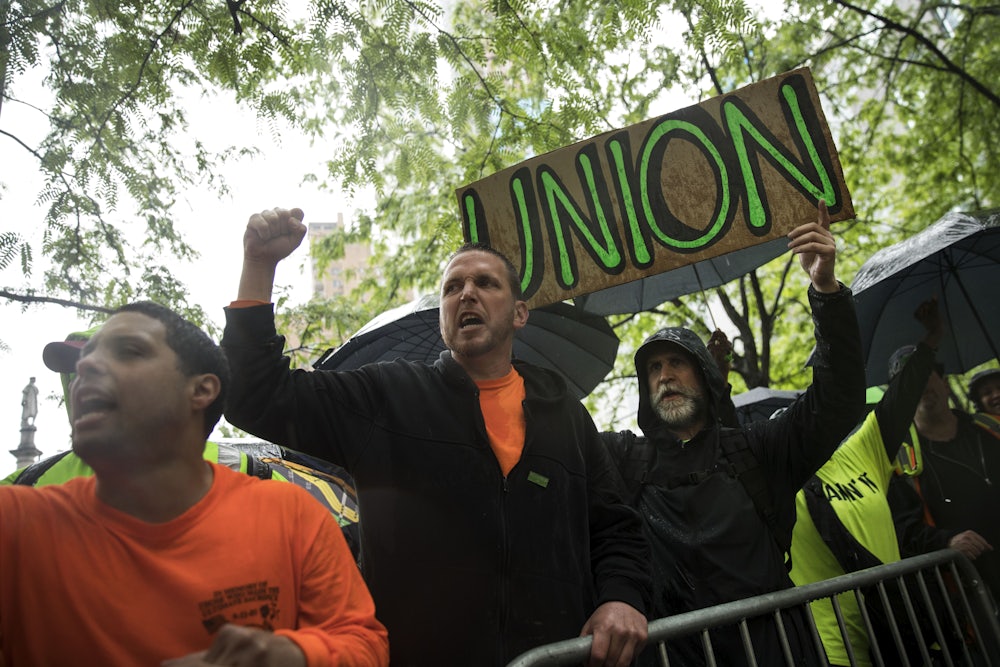Around February, Jakob Meils, an English teacher at East High School in Denver, received a postcard with a simple pitch: As food and gas prices skyrocketed, the best way for workers like Meils to get more money in their paychecks would be to opt out of union dues. The card included a link where he could fill out a form and have it mailed to his union at no cost, saving him upward of $950 per year.
“It sat on my couch for a couple of days,” he said, “but they kept coming, and by the summer I remember being surprised I was getting them so often.” Meils then looked more closely at the sender: a free-market think tank from Olympia, Washington, called the Freedom Foundation. He was skeptical of its motives and noted the pitch to opt out and save was even less convincing after the recent wins his union had brokered. “The difference was substantial enough that my wife and I were able to have a kid and start saving for a house,” he said of the deal his union reached after Denver teachers went on strike in 2019. “It would never occur to me to leave because of a mailer.”
The Freedom Foundation has been waging a campaign to encourage public-sector workers—from teachers to firefighters—to opt out of their unions since 2014. The group was founded by former teacher and private school advocate Lynn Harsh and Washington state legislator and budget hawk Bob Williams in 1991 after Williams’s failed gubernatorial run, but for years toiled out of the spotlight on small austerity campaigns to shrink state budgets. That changed dramatically in 2018 following the U.S. Supreme Court’s Janus decision, which held that public-sector workers cannot be required to pay dues if they choose not to become members of their union. The decision overturned 41 years of precedent that argued nonmembers still benefited from union efforts and could therefore be required to pay fees. From before Janus to 2020, Freedom Foundation’s revenues ballooned by 38 percent, and it began its opt-out campaigns in earnest in Washington, Oregon, and California.
After first focusing on the West Coast, the Freedom Foundation took its campaign national last year. It grew preexisting efforts in Pennsylvania and Ohio, and earlier this year in August it televised commercials in Florida and California. The group launched a New York campaign in October, reaching out to 23,000 civil service workers, all part of its ambitious goal for 2024, when it hopes to have defunded public-sector unions of a total of $1.2 billion.
Through door knocking and postcard mailers, a presence in online conservative news networks, and an onslaught of lawsuits against unions around the nation, the group says it’s now aided more than 131,000 public-sector workers in opting out, costing unions more than $258 million in dues. If the figures are accurate—Freedom Foundation did not respond to multiple requests for this story—it would mean nearly 2 percent of the total current unionized public-sector workforce left with the think tank’s help. But public-sector union leaders insist the group and others like it are more of a nuisance than an impactful force and that a host of other factors, including a shrinking workforce, loom as larger threats to their ranks.
Behind testimonials of small-town, blue-collar workers, the group is guided by an ambitious and national agenda. Freedom Foundation’s chief executive, Aaron Withe, who started as an organizer for the group in 2015, wrote that “government unions are a root cause of every growing national dysfunction in America.” Withe regularly brings his message to national media, penning op-eds in The Wall Street Journal and Fox News online, joining Sean Hannity’s radio show, and making cable appearances on Fox and Friends. The think tank has called for the wholesale abolishment of the Department of Education and has garnered support from top conservative donors, including groups connected with the Koch brothers. Its 2020 IRS filings—the latest available—show revenues of $6.4 million.
“This is a political effort,” said Lane Windham, a historian and associate director of Georgetown University’s Kalmanovitz Initiative for Labor and the Working Poor. “They understand that union membership often buoys the Democratic Party,” she said, adding that Freedom Foundation campaigns and others like it have specifically targeted blue states.
The group is always ready to boast about its purported impact, toting testimonial videos of opt-outs like one featuring Margy Schoenheit, a sixth grade humanities teacher outside Portland, Oregon, who left her teachers union out of concern that it was forcing “critical race theory” and messages to defund the police into her classroom. Some left in opposition to their union’s politics and others to save on dues. The group doesn’t shy away from flashy campaigns, including one October demonstration in downtown Pittsburgh when organizers set up an inflatable cash wind tunnel, filled it with fake bills, and invited union members to see how much their union was spending.
But with a relatively small web presence and no public proof of the success of its opt-out efforts or how it measures them, Freedom Foundation’s specific impact on the public sector is difficult to quantify. In 2017, 34.4 percent of the public workforce was unionized, about 7.2 million people nationwide. By 2021, the number had dropped to about 6.9 million, but membership rates only declined slightly, now down to 33.9 percent.
Union leaders say the overall drop in ranks is thanks to rollbacks in government employment. Public-sector employment’s recent peak was during the Great Recession at 21.3 million workers, but that workforce had shrunk to 20.6 million by 2021.
The Ohio Federation of Teachers illustrates the thorniness of measuring Freedom Foundation’s sway on workers. The union lost 1,141 members during the 2020–2021 school year, about 7 percent of its membership. Freedom Foundation credits its campaigns for some of this decline, writing that teachers are “sick and tired of seeing students used as pawns in a destructive game of political chess.”
But Melissa Cropper, president of the Ohio Federation of Teachers, told me her office has received just three dozen opt-out forms from the group, and many contained errors or came from workers who were not actually members or belonged to a different union. Instead, a spokesperson from OFT said, the decline was Covid-related and caused by an overall drop in employment at many of the state’s school districts.
In other states where Freedom Foundation has been active longest, overall union membership has actually grown, though the figures represent membership in the private and public sectors combined. The share of Washington’s workforce that was unionized rose from 17.4 percent in 2016 to 19 percent in 2021, and in Oregon the share rose from 13.5 percent to 17.8 percent during the same period.
A range of public-sector union leaders said despite a slow rebound of public-sector employment after it dropped during the onset of the pandemic, they have plenty of reasons to be optimistic. The Chicago Teachers Union has grown its membership from 26,758 in 2017 to 29,001 as of October. Chris Geovanis, the union’s communications director, attributes that growth to a system of local delegates in each school community as well as extensive education campaigns about the values of dues that began in 2017 in preparation for the Janus decision. “We’re an organizing union, and that includes constant organizing among our rank and file to ensure that people understand the historical and political contexts of Janus,” Geovanis said. “That work is ongoing.”
To Windham, unions that have let new organizing take a back seat in recent years might leave their members more susceptible to Freedom Foundation’s messages. “When unions talk with their members about the impact the organization can have on their lives, that sways people,” she said. “The ones that have not had those conversations have been more susceptible to drops in their members because for many years they didn’t have to actually engage.”
If Freedom Foundation hasn’t made a significant dent in membership, its relentless stream of lawsuits still takes up a significant amount of union resources. The group is litigating 80 union-related lawsuits around the country, as of September. Suits have included: one against AFSCME in Ohio about refunding vacation time back to members who left the union, a case in Oregon challenging a law that would allow legislative workers to unionize, and one against a number of unions in Washington for allegedly refusing to accept packages of mail from union members opting out. The group isn’t subtle about wanting to be a nuisance with these lawsuits. “The Freedom Foundation’s aggressive legal actions are designed to work as ‘kill shots’ that dramatically disrupt union political operations,” Withe wrote in a Freedom Foundation pamphlet.
The group’s effort leaves union leaders tied up, said Randi Weingarten, president of the American Federation of Teachers. “The amount of money and attention that is spent just dealing with these claims is terrible,” she told me. “They are well funded, and what they’ll do is lie, divide, and use culture wars by any means necessary.”
While it occupies unions with lawsuits, Freedom Foundation’s messages also tries to drive a wedge between national unions and small locals, where workers are more likely to have close contacts and more regular relationships. A section of the group’s Opt Out Today website even has instructions for workers who would like to keep their dollars within their local only, which Freedom Foundation says will help them “stand in solidarity with their coworkers and know they are supporting the valued services the union provides.”
Cropper, at Ohio Federation of Teachers, said for the few workers in her union frustrated enough to submit opt-out paperwork, an engaged local union can win them back. “They might think they want to drop out of the national, but they love their local,” she said. “Once they find out they’ll lose contact with their local, they stop.”


